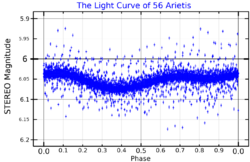Astronomy:56 Arietis
| Observation data Equinox J2000.0]] (ICRS) | |
|---|---|
| Constellation | Aries |
| Right ascension | 03h 12m 14.2461s[2] |
| Declination | +27° 15′ 25.086″[2] |
| Apparent magnitude (V) | 5.79[3] (5.75 – 5.81)[4] |
| Characteristics | |
| Spectral type | B9pSi[5] |
| U−B color index | −0.42[3] |
| B−V color index | −0.12[3] |
| Variable type | SX Ari[4] |
| Astrometry | |
| Radial velocity (Rv) | +18.0[6] km/s |
| Proper motion (μ) | RA: +11.899(94)[2] mas/yr Dec.: −18.294(88)[2] mas/yr |
| Parallax (π) | 7.8671 ± 0.0651[2] mas |
| Distance | 415 ± 3 ly (127 ± 1 pc) |
| Absolute magnitude (MV) | +0.25[7] |
| Details | |
| Mass | 2.61[8] M☉ |
| Radius | 2.58[8] R☉ |
| Luminosity | 151[8] L☉ |
| Surface gravity (log g) | 3.97[8] cgs |
| Temperature | 12,420[8] K |
| Metallicity [Fe/H] | +0.45[9] dex |
| Rotation | 0.7278972 days[7] |
| Rotational velocity (v sin i) | 160[9] km/s |
| Age | 174[10] Myr |
| Other designations | |
| Database references | |
| SIMBAD | data |
56 Arietis is a single,[12] variable star in the northern zodiac constellation of Aries. It has the variable star designation SX Arietis, while 56 Arietis is the Flamsteed designation. This object is visible to the naked eye as a faint, blue-white hued point of light with a baseline apparent visual magnitude of 5.79.[3] The estimated distance to this star is approximately 415 light-years (127 parsecs), based on parallax,[2] and it is drifting further away with a radial velocity of +18 km/s.[6]
This is a magnetic, chemically peculiar star of the silicon type with a stellar classification of B9pSi,[5] and it has a rapid rotation period of 17.5 hours.[13] This period is increasing by about two seconds every hundred years.[14] The star displays evidence of a five year period for procession of its axis.[15] 56 Arietis is the prototype of a class of variable stars known as SX Arietis variables, which are rotationally variable stars with strong magnetic fields. It ranges in brightness from 5.75 down to 5.81 with a cyclical period matching its rotation rate.[4]
References
- ↑ Wraight, K. T.; Fossati, L.; Netopil, M.; Paunzen, E.; Rode-Paunzen, M.; Bewsher, D.; Norton, A. J.; White, Glenn J. (February 2012). "A photometric study of chemically peculiar stars with the STEREO satellites – I. Magnetic chemically peculiar stars". Monthly Notices of the Royal Astronomical Society 420 (1): 757–772. doi:10.1111/j.1365-2966.2011.20090.x. Bibcode: 2012MNRAS.420..757W. https://ui.adsabs.harvard.edu/abs/2012MNRAS.420..757W/abstract. Retrieved 26 October 2021.
- ↑ 2.0 2.1 2.2 2.3 2.4 Vallenari, A. et al. (2022). "Gaia Data Release 3. Summary of the content and survey properties". Astronomy & Astrophysics. doi:10.1051/0004-6361/202243940 Gaia DR3 record for this source at VizieR.
- ↑ 3.0 3.1 3.2 3.3 Nicolet, B. (1978), "Photoelectric photometric Catalogue of homogeneous measurements in the UBV System", Astronomy and Astrophysics Supplement Series 34: 1–49, Bibcode: 1978A&AS...34....1N.
- ↑ 4.0 4.1 4.2 Samus, N. N. et al. (2017), "General Catalogue of Variable Stars", Astronomy Reports, 5.1 61 (1): 80–88, doi:10.1134/S1063772917010085, Bibcode: 2017ARep...61...80S.
- ↑ 5.0 5.1 Cowley, A. et al. (April 1969), "A study of the bright A stars. I. A catalogue of spectral classifications", Astronomical Journal 74: 375–406, doi:10.1086/110819, Bibcode: 1969AJ.....74..375C
- ↑ 6.0 6.1 Bonsack, Walter K. (February 1958), "Wavelength Variations in the Spectrum of 56 ARIETIS", Publications of the Astronomical Society of the Pacific 70 (412): 90, doi:10.1086/127180, Bibcode: 1958PASP...70...90B
- ↑ 7.0 7.1 North, P. (June 1998), "Do SI stars undergo any rotational braking?", Astronomy and Astrophysics 334: 181–187, Bibcode: 1998A&A...334..181N.
- ↑ 8.0 8.1 8.2 8.3 8.4 Glagolevskij, Yu. V. (2019). "On Properties of Main Sequence Magnetic Stars". Astrophysical Bulletin 74 (1): 66. doi:10.1134/S1990341319010073. Bibcode: 2019AstBu..74...66G.
- ↑ 9.0 9.1 Ghazaryan, S.; Alecian, G.; Hakobyan, A. A. (2018). "New catalogue of chemically peculiar stars, and statistical analysis". Monthly Notices of the Royal Astronomical Society 480 (3): 2953–2962. doi:10.1093/mnras/sty1912. Bibcode: 2018MNRAS.480.2953G.
- ↑ Gontcharov, G. A. (2012). "Dependence of kinematics on the age of stars in the solar neighborhood". Astronomy Letters 38 (12): 771–782. doi:10.1134/S1063773712120031. Bibcode: 2012AstL...38..771G.
- ↑ "56 Ari". SIMBAD. Centre de données astronomiques de Strasbourg. http://simbad.u-strasbg.fr/simbad/sim-basic?Ident=56+Ari.
- ↑ Eggleton, P. P.; Tokovinin, A. A. (September 2008), "A catalogue of multiplicity among bright stellar systems", Monthly Notices of the Royal Astronomical Society 389 (2): 869–879, doi:10.1111/j.1365-2966.2008.13596.x, Bibcode: 2008MNRAS.389..869E.
- ↑ Ziznovsky, J. et al. (January 2000), "The Variable Light Curve of 56 Arietis", Information Bulletin on Variable Stars 4835: 1, Bibcode: 2000IBVS.4835....1Z.
- ↑ Sokolov, N. A. (December 2006), "Ultraviolet variability of the magnetic chemically peculiar star 56 Arietis", Monthly Notices of the Royal Astronomical Society 373 (2): 666–676, doi:10.1111/j.1365-2966.2006.11037.x, Bibcode: 2006MNRAS.373..666S.
- ↑ Adelman, Saul J.; Malanushenko, V.; Ryabchikova, T. A.; Savanov, I. (September 2001), "On the rotation of the chemically peculiar magnetic star 56 Arietis", Astronomy and Astrophysics 375 (3): 982–988, doi:10.1051/0004-6361:20010895, Bibcode: 2001A&A...375..982A.
External links
 |


